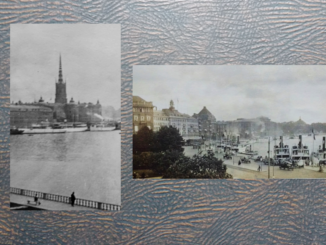
© Always Worth Saying 2023, Going Postal
After spending much of one’s life in Carlisle, being unenthusiastic about Monaco might be a challenge. Or might it?
First, a disambiguation. Monaco is the name of a principality of less than 500 acres which lies at the halfway point between the 18 Cote D’Azor miles separating Nice from the Italian frontier. Monte Carlo is a locale in and around Monaco’s Casino Square.
Picture One (above) is from my grandparents’ 1958 road trip and shows the classic panorama of a near-deserted harbour.
To the left can be seen the rising arched viaduct of the Avenue d’Ostend. Puffins with a decent memory will recall, because of their common interest in ports and casinos, Monte Carlo is twinned with the Belgian seaside resort. The Formula One Grand Prix circuit rises along d’Ostend to run past the Hôtel de Paris Monte-Carlo, the white building to the right.
The two-mile-long track (lapable in 72 seconds if you’re Dame Louise of Hamilton) continues to the casino and opera house which can be seen as the towers to the right of the hotel. The opera is also called the Salle Garnier with the attached gaming establishment consisting of other rooms such as the Salle Europe and Salle Schmit.
At this point we have our regular excuse to mention Puffin’s favourite French film star Mlle Véro who voiced a documentary about Léo Ferré, an homme libre and Monegasque chanteur synonymous with the local opera. Her opening can be enjoyed here (behave yourselves) accompanied by THAT voice.
Later in this series you will see Mlle Véro. Bear in mind we are no longer young. Although rude to speculate upon a lady’s age, my best guess (La Véro having previously fibbed about her years, as a lady is entitled to), puts her at sixty-six.
On the landward side of the opera house, as part of the same complex, sits Casino Square around which the F1 circuit laps before heading back down to the harbour through Le Tunnel – yet to be built in 1958.
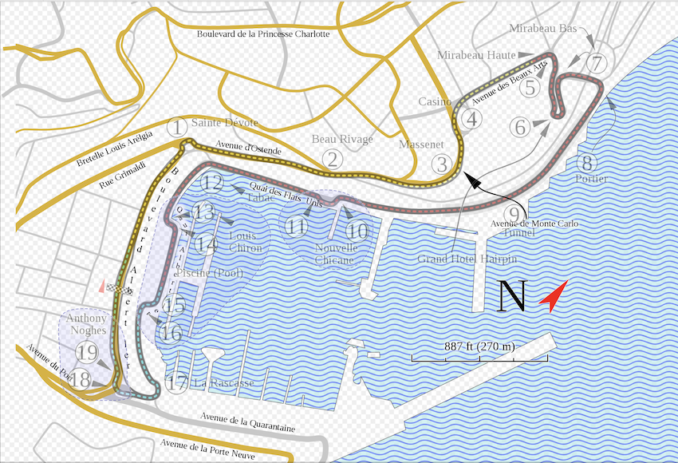
Monte Carlo track map ,
Will Pittenger – Licence CC BY-SA 3.0
Le Tunnel belongs to the Auditorium Rainier III complex which extends into the sea in an area called Larvotto. The harbour is also now extended with outer walls beyond the older, straight abutments topped with pillars in Photo One.
Larvaotto, between the Salle Garnier and the Mediterranian, became the location of Monte Carlo railway station as, at first, the Nice to Ventimiglia line hugged the coast while passing through. Monaco station sat behind the Royal Palace (where the 1958 photograph was taken).
My grandparents’ 1950s visits threatened to be fatal to local railway services. You’ll remember the Vevey to Blonay tramway closed the year they visited the Lake Geneva lakeside town. Likewise, in 1958 a new tunnel resulted in Gare Larvotto closing, albeit not until 1965. After this, the Auditorium Rainier emerged from the site with part of it extended out to sea in a development including the famous F1 circuit’s Le Tunnel.
The Grand Prix is held in May. In 1958, France’s Maurice Trintignant won the race despite our own Tony Brooks being in pole position, our own Mike Hawthorn completing the fastest lap and Stirling Moss, Jack Brabham and Graham Hill being in attendance. The illustrious lineup didn’t include world champion Juan Fangio, distracted to the United States to prepare for the Indianapolis 500.
A young English whipper snapper called Bernie Eccleston did compete. However, the 27-year-old failed to complete his qualifying laps, after which he concentrated on the business side of things. The rest, as they say, is history. Also amongst the 15 out of 31 entrants who didn’t make the cut was Maria Teresa de Filippis, the daughter of Italian Count, Serino Francesco De Filippis, and a Spanish noblewoman, Narcisa Anselmi Balaguer Roca de Togores y Ruco y Perpignan.
Eleven seconds behind Brooks this time, Maria entered five races between 1958 and 1959, started in three and finished in one – passing a Belgian chequered flag in last place.
She retired from professional racing in 1959 but re-emerged two decades later when she joined the International Club of Former F1 Grand Prix Drivers. By 1997 promoted to be their vice president before passing in 2016, aged 89.
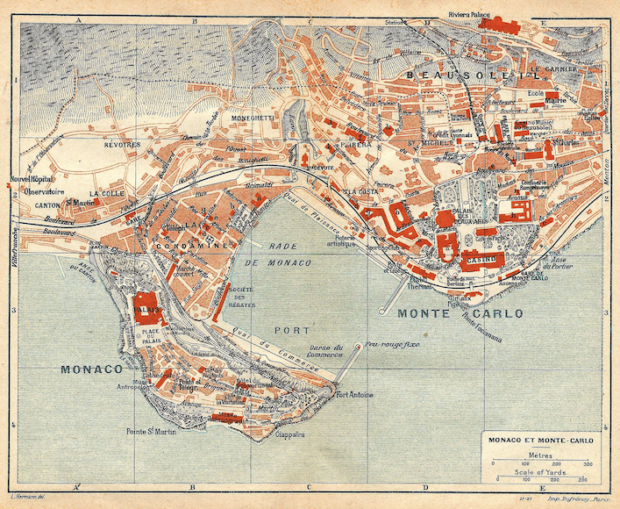
Carte de Monaco & Monte-Carlo,
édition Hachette, 1922 – Public domain
In the modern day, the old railway route from Monaco station is the Boulevard de Larvotto. The 1921 map above also includes another line, the Chemin de fer à crémaillère de La Turbie à Monte-Carlo (to the top right). Somewhat of a misnomer, close inspection reveals the border with France doesn’t run along a mountain ridge or river but through the urban area.
The French side is Beausoleil and that held the terminus. A rack and pinion railway on the metre gauge, trains ran for 1 mile and 52 chains to La Turbie from 1894 until 1932 when the line closed following a fatal accident.
In my day, the 1980s, Monaco welcomed arrivals by train at the same location as marked on the 1921 map. However, it perished too. As we are beginning to realise, the principality is one giant building site, the only real estate certainty being you aren’t going to keep your view.
Le Tunnel complex is having its outlook ruined by a project called Bay House, reclaimed from the Med along Princess Grace promenade between Larvotto Beach and the Tunnel.
The new buildings are an out-of-place monstrosity with the expansion only taking place because of the money. In times when you have to sell a kidney to buy a tub of margarine at Aldi, Puffins will be unsurprised to learn prices for properties in the Bay House complex start at an eye-watering €65,000 … per square meter.
Back to the old Gare Monaco at La Colle. That’s gone too and is covered by a concrete raft with high rises on top and roads underneath utilising the old railway line and tunnels. The iron road now fully tunnelled, a new sub-surface station was built. The whole through route is now below the ground or rafts supporting high-rise buildings.
Our original Photo One must have been taken from the Rue De Ramparts and via Street View we can stand on the exact spot. On the previous page of my grandparent’s family album, showing Cannes harbour, we decided the floaty metal stuff belonged to the nuevo riches.
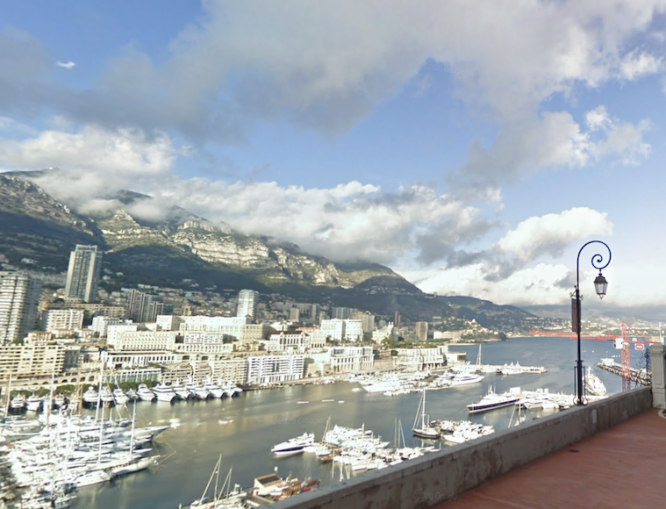
© Google Street View 2023, Google
This time around we shall allocate to the seriously well-off. The mega well-off also visit but their yachts are too big for the harbour with the unfortunate souls having to trouble helipads at the blunt ends of their giga-vessels.
Unfortunately, the Google Car visited in 2010. In the intervening years the vista changed once more with the Yacht Club of Monaco built between the old and new harbour walls. A Foster and Partners design completed in 2014, Lord Norman slapped the otherwise impressive ship-shaped view spoiler in front of the Thermes Marins Monte-Carlo.
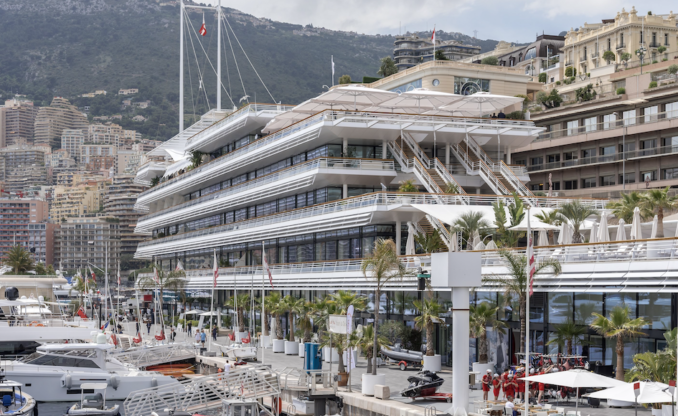
Yacht Club de Monaco,
Alexandre Prevot – Licence CC BY-SA 2.0
These days the Thermes Marins, literally ‘marine thermal baths’, is a ‘Wellness Centre’. Admittance is €150 a day. A super anti-ageing facial will set you back a hair-greying and wrinkle-inducing €300. To avoid the whiff from the types who can only afford a yacht squeezable into the port, the Thermes’ reassures patrons its saltwater pool is filled with ‘Mediterranean seawater drawn from a depth of 37 metres, 400 metres out from the coast.’
The baths are administered by the rather splendid sounding Société Anonyme des Bains de Mer et du Cercle des Etrangers à Monaco, a publically traded company majority owned by the government. Besides the baths, they are responsible for the Hotel de Paris, the opera and the casino. Founded in 1863 by Prince Charles III, the original investors included the canny Bishop of Monaco and a certain Cardinal Pecci who became better known as Pope Leo XIII.
Although struggling casinos already existed in the badly connected and impoverished port – population 2,000 in the 1860s – the operation would be scaled up with a new casino and opera and by rail connections to both Nice and the Italian border.
The plan worked. Within months the high and mighties of Nice petitioned the French Senate to annex Monaco and close the tables as fellow citizens of lower morals travelled east in haste and numbers to lose all their money.
Speaking of morals, note the use of the word ‘etrangers’ in the company name. On ethical grounds, Monegasques are forbidden to enter the gaming rooms of the casino and from working or gambling on the premises. Not so the English travelling classes, neither in the late 1950s nor 1980s. Next time we shall have a wander about the principality, starting with the casino, but before then I must take this opportunity to wish Puffins a restful, spiritual, prosperous and happy Easter.
© Always Worth Saying 2023



